
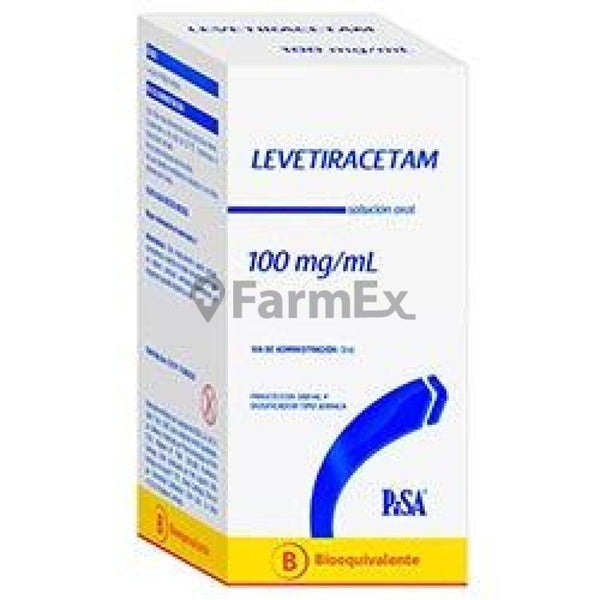
ЛЕВЕТИРАЦЕТАМ ТАРБІС 100 мг/мл ОРАЛЬНИЙ РОЗЧИН

Запитайте лікаря про рецепт на ЛЕВЕТИРАЦЕТАМ ТАРБІС 100 мг/мл ОРАЛЬНИЙ РОЗЧИН

Інструкція із застосування ЛЕВЕТИРАЦЕТАМ ТАРБІС 100 мг/мл ОРАЛЬНИЙ РОЗЧИН
Введення
Опис:інформація для користувача
Леветирацетам Тарбіс 100 мг/мл оральний розчин ЕФГ
Леветирацетам
Прочитайте уважно весь опис перед тим, як почнете приймати цей препарат, оскільки він містить важливу інформацію для вас.
- Збережіть цей опис, оскільки вам може знадобитися знову його прочитати.
- Якщо у вас є якісь питання, проконсультуйтеся з вашим лікарем або фармацевтом.
- Цей препарат призначений лише вам, і не слід давати його іншим людям, навіть якщо вони мають такі самі симптоми, як у вас, оскільки це може нашкодити їм.
- Якщо ви відчуваєте побічні ефекти, проконсультуйтеся з вашим лікарем або фармацевтом, навіть якщо це побічні ефекти, які не вказані в цьому описі.
Зміст опису:
- Що таке Леветирацетам Тарбіс і для чого він використовується
- Що потрібно знати перед тим, як почати приймати Леветирацетам Тарбіс
- Як приймати Леветирацетам Тарбіс
- Можливі побічні ефекти
- Збереження Леветирацетаму Тарбіса
- Зміст упаковки та додаткова інформація
1. Що таке Леветирацетам Тарбіс і для чого він використовується
Леветирацетам Тарбіс 100 мг/мл оральний розчин є протиепілептичним препаратом (препаратом для лікування епілепсії).
Леветирацетам Тарбіс використовується:
- самостійно (без потреби в інших протиепілептичних препаратах) у дорослих і підлітків від 16 років з епілепсією, яка була діагностована нещодавно, для лікування парціальних судом з або без вторинної генералізації.
- у поєднанні з іншими протиепілептичними препаратами для лікування:
- парціальних судом з або без генералізації у дорослих, підлітків, дітей і немовлят від 1 місяця життя.
- міоклонічних судом у дорослих і підлітків від 12 років з ювенільною міоклонічною епілепсією.
- примарних тоніко-клонічних судом у дорослих і підлітків від 12 років з ідіопатичною генералізованою епілепсією.
2. Що потрібно знати перед тим, як почати приймати Леветирацетам Тарбіс
Не приймайте Леветирацетам Тарбіс
- Якщо ви алергічні (гіпersenситивні) до леветирацетаму або до будь-якого іншого компонента цього препарату (включно з розділом 6).
Попередження та обережність
Проконсультуйтеся з вашим лікарем або фармацевтом перед тим, як почати приймати Леветирацетам Тарбіс.
- Якщо у вас є проблеми з нирками, слідуйте інструкціям вашого лікаря, який вирішить, чи потрібно коригувати дозу.
- Якщо ви спостерігаєте будь-яке зниження росту вашої дитини або несподіване розвиток статевих ознак, зверніться до вашого лікаря.
- Якщо ви помітите збільшення тяжкості судом (наприклад, збільшення кількості), зверніться до вашого лікаря.
- Дрібна кількість людей, які приймають протиепілептичні препарати, такі як леветирацетам, мали думки про самознищення або суїцид. Якщо у вас є будь-які симптоми депресії та/або суїцидальні думки, зверніться до вашого лікаря.
Прийом Леветирацетаму Тарбіса з іншими препаратами
Повідомте вашого лікаря або фармацевта, якщо ви приймаєте, приймали нещодавно або можете приймати будь-який інший препарат, включно з тим, який можна придбати без рецепта.
Прийом Леветирацетаму Тарбіса з їжею, напоями та алкоголем
Ви можете приймати Леветирацетам Тарбіс з або без їжі. За мірку безпеки не приймайте Леветирацетам Тарбіс з алкоголем.
Вагітність і лактація
Якщо ви вагітні або перебуваєте в період лактації, вважаєте, що можете бути вагітною або плануєте завагітніти, проконсультуйтеся з вашим лікарем або фармацевтом перед тим, як використовувати цей препарат.
Леветирацетам Тарбіс не повинен використовуватися під час вагітності, якщо це не абсолютно необхідно. Не відомо можливий ризик для дитини під час вагітності. У дослідженнях на тваринах леветирацетам показав нежелані ефекти на репродукцію при дозах, вищих за ті, які ви можете потребувати для контролю судом. Не рекомендується природне годування під час лікування.
Водіння автомобіля та використання машин
Леветирацетам Тарбіс може змінити вашу здатність водити автомобіль або використовувати інструменти чи машини, оскільки він може викликати сонливість. Це більш ймовірно на початку лікування або при збільшенні дози. Не слід водити автомобіль чи використовувати машини, доки не буде підтверджено, що ваша здатність виконувати ці дії не є порушеною.
Леветирацетам Тарбіс міститьпара-гідроксибензоат метилу (Е218), пара-гідроксибензоат пропилу та мальтитол.
Він може викликати алергічні реакції (можливо, затримані) через пара-гідроксибензоат метилу (Е218) та пара-гідроксибензоат пропилу (Е216).
Цей препарат містить мальтитол. Якщо ваш лікар сказав вам, що ви маєте непереносимість до певних цукрів, проконсультуйтеся з ним перед тим, як приймати цей препарат.
3. Як приймати Леветирацетам Тарбіс
Слідуйте точно інструкціям щодо прийому Леветирацетаму Тарбіса, вказаним вашим лікарем. У разі сумнівів проконсультуйтеся з вашим лікарем або фармацевтом.
Рекомендована доза Леветирацетаму Тарбіса становить два рази на добу, один раз уранці та один раз увечері, приблизно о одній і тій самій годині кожного дня.
Прийом оральної розчини відповідно до інструкцій вашого лікаря.
Монотерапія
Доза для дорослих і підлітків (від 16 років):
Виміряйте відповідну дозу за допомогою шприца на 10 мл, включеного до упаковки для пацієнтів від 4 років життя.
Загальна доза: Леветирацетам Тарбіс приймається два рази на добу, розділені на дві рівні дози, кожна з яких становить від 5 мл (500 мг) до 15 мл (1 500 мг).
Коли ви починаєте приймати Леветирацетам Тарбіс, ваш лікар призначить вам нижчу дозупротягом двох тижнів перед тим, як призначити загальну мінімальну дозу.
Комбінаційна терапія
Доза для дорослих і підлітків (від 12 до 17 років) з масою тіла 50 кг та більше:
Виміряйте відповідну дозу за допомогою шприца на 10 мл, включеного до упаковки для пацієнтів від 4 років життя.
Загальна доза: Леветирацетам Тарбіс приймається два рази на добу, розділені на дві рівні дози, кожна з яких становить від 5 мл (500 мг) до 15 мл (1 500 мг).
Доза для дітей від 6 місяців життя та старше:
Ваш лікар призначить вам відповідну лікарську форму Леветирацетаму Тарбіса згідно з віком, масою тіла та дозою.
Для дітей від 6 місяців до 4 років виміряйте відповідну дозу за допомогою шприца на 3 мл, включеного до упаковки.
Для дітей старше 4 років виміряйте відповідну дозу за допомогою шприца на 10 мл, включеного до упаковки.
Загальна доза: Леветирацетам Тарбіс приймається два рази на добу, розділені на дві рівні дози, кожна з яких становить від 0,1 мл (10 мг) до 0,3 мл (30 мг) на кілограм маси тіла дитини (див. приклади доз у таблиці нижче).
Доза для дітей від 6 місяців життя та старше:
Маса тіла | Початкова доза: 0,1 мл/кг двічі на добу | Максимальна доза: 0,3 мл/кг двічі на добу |
6 кг | 0,6 мл двічі на добу | 1,8 мл двічі на добу |
8 кг | 0,8 мл двічі на добу | 2,4 мл двічі на добу |
10 кг | 1 мл двічі на добу | 3 мл двічі на добу |
15 кг | 1,5 мл двічі на добу | 4,5 мл двічі на добу |
20 кг | 2 мл двічі на добу | 6 мл двічі на добу |
25 кг | 2,5 мл двічі на добу | 7,5 мл двічі на добу |
Від 50 кг | 5 мл двічі на добу | 15 мл двічі на добу |
Дозування для немовлят (від 1 місяця до менш як 6 місяців):
Для немовлят від 1 місяця до менш як 6 місяців, виміряйте відповідну дозу за допомогою шприца на 1 мл, включеного до упаковки.
Загальна доза: Леветирацетам Тарбіс приймається два рази на добу, розділені на дві рівні дози, кожна з яких становить від 0,07 мл (7 мг) до 0,21 мл (21 мг) на кілограм маси тіла немовляти (див. приклади доз у таблиці нижче).
Дозування для немовлят (від 1 місяця до менш як 6 місяців):
Маса тіла | Початкова доза: 0,07 мл/кг двічі на добу | Максимальна доза: 0,21 мл/кг двічі на добу |
4 кг | 0,3 мл двічі на добу | 0,85 мл двічі на добу |
5 кг | 0,35 мл двічі на добу | 1,05 мл двічі на добу |
6 кг | 0,45 мл двічі на добу | 1,25 мл двічі на добу |
7 кг | 0,5 мл двічі на добу | 1,5 мл двічі на добу |
Форма прийому:
Після вимірювання відповідної дози за допомогою відповідного шприца, Леветирацетам Тарбіс можна приймати, розбавляючи оральний розчин у склянці води або в бутельці.
Інструкції щодо правильного прийому:
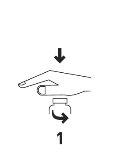
- Відкрити флакон: стиснути кришку та повернути у протилежному напрямку годинникової стрілки (рисунок 1).
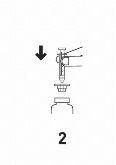 Вставте адаптер шприца у горлечок флакона (рисунок 2). Переконайтесь, що він добре закріплений.
Вставте адаптер шприца у горлечок флакона (рисунок 2). Переконайтесь, що він добре закріплений.- Візьміть шприц та вставте його у отвір адаптера (рисунок 2).
- Помістіть флакон дном униз (рисунок 3).
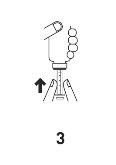
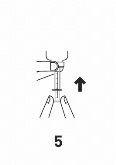

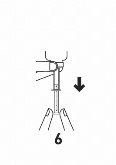 Наповніть шприц невеликою кількістю розчину, опустивши поршень (рисунок 4), а потім піднімаючи його, щоб видалити будь-які бульбашки (рисунок 5), нарешті опустіть поршень до позначки, яка відповідає призначеній лікарем дозі в мілілітрах (мл) (рисунок 6).
Наповніть шприц невеликою кількістю розчину, опустивши поршень (рисунок 4), а потім піднімаючи його, щоб видалити будь-які бульбашки (рисунок 5), нарешті опустіть поршень до позначки, яка відповідає призначеній лікарем дозі в мілілітрах (мл) (рисунок 6).
- Помістіть флакон дном угору.
- Видаліть шприц з адаптера.
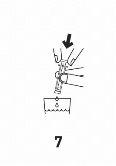 Видаліть вміст шприца у склянку води або в бутельці, опустивши поршень до кінця (рисунок 7).
Видаліть вміст шприца у склянку води або в бутельці, опустивши поршень до кінця (рисунок 7).
- Випийте весь вміст склянки.
- Закрийте флакон кришкою з пластиковим гайкою.
- Вимийте шприц водою (рисунок 8).

Тривалість лікування:
- Леветирацетам Тарбіс використовується як тривале лікування. Ви повинні продовжувати лікування Леветирацетамом Тарбісом протягом часу, вказаного вашим лікарем.
- Не припиняйте лікування без поради вашого лікаря, оскільки це може збільшити кількість судом. Якщо ваш лікар вирішить припинити лікування Леветирацетамом Тарбіса, він/вона дасть вам інструкції щодо поступового припинення прийому Леветирацетаму Тарбіса.
Якщо ви прийняли більше Леветирацетаму Тарбіса, ніж потрібно
У разі передозування або випадкового прийому проконсультуйтеся з вашим лікарем або фармацевтом чи зверніться до служби токсикологічної інформації, телефон: 91 562 04 20, вказавши препарат та кількість, прийняту.
Можливі побічні ефекти передозування Леветирацетаму Тарбіса включають сонливість, агресивність, порушення свідомості, пригнічення дихання та кому.
Зверніться до вашого лікаря, якщо ви прийняли більше розчину, ніж потрібно. Ваш лікар встановить найкраще лікування передозування.
Якщо ви забули прийняти Леветирацетам Тарбіс:
Зверніться до вашого лікаря, якщо ви пропустили одну чи більше доз.
Не приймайте подвійну дозу, щоб компенсувати пропущені дози.
Якщо ви припинили лікування Леветирацетамом Тарбісом:
Як і у випадку з іншими протиепілептичними препаратами, припинення лікування Леветирацетамом Тарбісом повинно проводитися поступово, щоб уникнути збільшення кількості судом.
Якщо у вас є будь-які інші питання щодо використання цього препарату, зверніться до вашого лікаря або фармацевта.
4. Можливі побічні ефекти
Як і всі препарати, Леветирацетам Тарбіс може викликати побічні ефекти, хоча не всі люди їх відчувають.
Деякі з побічних ефектів, таких як сонливість, слабкість та головокружіння, можуть бути більш частими під час початку лікування або збільшення дози. Однак ці побічні ефекти повинні зменшуватися з часом.
Проконсультуйтеся з вашим лікарем негайно, або зверніться до відділення невідкладної допомоги найближчої лікарні, якщо ви відчуваєте:
- слабкість, головокружіння або труднощі з диханням, оскільки ці можуть бути ознаками важкої алергічної реакції (анafilактичної).
- опухання обличчя, губ, язика або горла (ангіоневротичний едем)
- симптоми грипу та висипка на обличчі, followed by тривалу висипку з підвищеною температурою, підвищеними рівнями ферментів печінки в аналізі крові та збільшенням кількості певного типу білих клітин (еозінофілів) та лімфатичних вузлів (реакція гіпersenситивності до препарату з еозінофілією та системними симптомами (DRESS))
- симптоми, такі як низький об'єм сечі, втома, нудота, блювота, запаморочення та опухання ніг, рук або ніг, оскільки це може бути ознакою раптового зниження функції нирок
- висипка на шкірі, яка може утворювати пухирці та може виглядати як маленькі цілі (темні центри, оточені більш світлим кольором, з темним кільцем навколо краю) (еритема мультиформна)
- висипка на шкірі, яка може викликати пухирці та лущення шкіри, особливо навколо рота, носа, очей та геніталій (синдром Стівенса-Джонсона)
- форма, яка є більш важкою та викликає лущення шкіри на більш ніж 30% поверхні тіла (токсична епідермальна некроліз)
- ознаки важких змін у психіці або якщо хтось навколо вас помічає ознаки сплутаності, сонливості (задумливості), амнезії (втрати пам'яті), порушення пам'яті (забування), порушення поведінки чи інших неврологічних ознак, включаючи неконтрольовані рухи. Це можуть бути ознаки енцефалопатії.
Частота можливих побічних ефектів, перелічених нижче, визначається наступним чином:
Дуже часті (можуть впливати на більше 1 з 10 пацієнтів)
Часті (можуть впливати до 1 з 10 пацієнтів)
Нечасті (можуть впливати до 1 з 100 пацієнтів)
Рідкі (можуть впливати до 1 з 1 000 пацієнтів)
Дуже рідкі (можуть впливати на менше 1 з 1 000 пацієнтів)
Частота невідома (не може бути оцінена на основі доступних даних)
Дуже часті:
- насофарингіт;
- сонливість (чуття сонливості), головний біль.
Часті:
- анорексія (втрата апетиту);
- депресія, ворожість чи агресивність, тривога, безсоння, нервозність чи раздражливість;
- судоми, порушення рівноваги, головокружіння (чуття нестабільності), летаргія, тремор (тремор неволійний);
- вертіго (чуття обертання);
- кашель;
- біль у животі, діарея, диспепсія (важке травлення, печія та кислотність), блювота, нудота;
- висипка на шкірі;
- астенія/втома (чуття слабкості).
Нечасті:
- зниження кількості тромбоцитів, зниження кількості лейкоцитів;
- втрата ваги, збільшення ваги;
- спроби самознищення та суїцидальні думки, порушення психіки, порушення поведінки, галюцинації, гнів, сплутаність, панічна атака, емоційна нестабільність/зміни настрою, агресивність;
- амнезія (втрата пам'яті), порушення пам'яті (забування), порушення координації/атаксія (порушення координації рухів), парестезія ( оніміння);
- диплопія (подвійне бачення), розмите бачення;
- анормальні результати аналізів функції печінки;
- втрата волосся, екзема, свербіж;
- слабкість м'язів, міалгія (біль у м'язах);
- травма.
Рідкі:
- інфекція;
- зниження всіх типів клітин крові;
- самознищення, порушення особистості (проблеми поведінки), порушення мислення (повільне мислення, труднощі з концентрацією);
- спазми м'язів, які не піддаються контролю, що впливають на голову, тулуб та кінцівки, труднощі з контролем рухів, гіперкінез (гіперактивність);
- панкреатит (запалення підшлункової залози);
- неспроможність печінки, гепатит (запалення печінки);
- висипка на шкірі, яка може викликати пухирці, які можуть виглядати як маленькі цілі (темні центри, оточені більш світлим кольором, з темним кільцем навколо краю) (еритема мультиформна), висипка на шкірі, яка може викликати пухирці та лущення шкіри, особливо навколо рота, носа, очей та геніталій (синдром Стівенса-Джонсона) та форма, яка є більш важкою та викликає лущення шкіри на більш ніж 30% поверхні тіла (токсична епідермальна некроліз).
- зниження концентрації натрію у крові.
- раптове зниження функції нирок
- рабдоміоліз (розпад м'язової тканини) та збільшення креатинфосфокінази у крові. Частота значно вища у пацієнтів японської національності порівняно з пацієнтами іншої національності.
Якщо ви відчуваєте побічні ефекти, проконсультуйтеся з вашим лікарем або фармацевтом, навіть якщо це побічні ефекти, які не вказані в цьому описі.
5. Зберігання Леветирацетаму Тарбіс
Тримати цей лікарський засіб поза зоною видимості та досягнення дітей.
Не використовувати цей лікарський засіб після закінчення терміну придатності, вказаного на коробці та на флаконі після CAD. Термін придатності - останній день місяця, який вказано.
Не використовувати після 7 місяців після відкриття упаковки.
Зберігати в оригінальній упаковці, щоб захистити від світла. Тримати в вертикальному положенні.
Лікарські засоби не повинні викидатися у водопровідні труби чи сміття. Відкладати упаковки та лікарські засоби, які вам не потрібні, у пункт SIGRE аптеки. У разі сумнівів запитайте у свого фармацевта, як позбутися упаковок та лікарських засобів, які вам не потрібні. Таким чином, ви допоможете захистити навколишнє середовище.
6. Зміст упаковки та додаткова інформація
Склад Леветирацетаму Тарбіс
- Активний інгредієнт - леветирацетам. Кожен мл містить 100 мг леветирацетаму.
- Інші компоненти: гліцерол (E422), пара-гідроксибензоат пропілу (E216), пара-гідроксибензоат метилу (E218), гліцирризинат амонію, цитринова кислота моногідрат, цитрат натрію дигідрат, ацесульфам калію, мальтітол (E965), ароматизатор грейпфрута та очищена вода.
Вигляд продукту та зміст упаковки
Леветирацетам Тарбіс 100 мг/мл розвідний розчин для перорального прийому - прозорий та безбарвний рідкий засіб.
Леветирацетам Тарбіс упаковується у скляні флакони об'ємом 300 мл або 150 мл, розміщені в картонній коробці:
Флакон з коричневого скла об'ємом 150 мл з білим кришкою, що запобігає доступу дітей, разом з градуйованою піпеткою об'ємом 1 мл для перорального прийому та адаптером для піпетки. Ця упаковкапридатна для немовлят від 1 місяця до менш ніж 6 місяців.
Флакон з коричневого скла об'ємом 150 мл з білим кришкою, що запобігає доступу дітей, разом з градуйованою піпеткою об'ємом 3 мл для перорального прийому та адаптером для піпетки. Ця упаковкапридатна для немовлят та малих дітей від 6 місяців до менш ніж 4 років.
Флакон з коричневого скла об'ємом 300 мл з білим кришкою, що запобігає доступу дітей, разом з градуйованою піпеткою об'ємом 10 мл для перорального прийому та адаптером для піпетки. Ця упаковкапридатна для дітей від 4 років, підлітків та дорослих.
Можливо, що тільки деякі розміри упаковок будуть продаватися.
Власник дозволу на торгівлю та відповідальна особа за виробництво
Власник дозволу на торгівлю
Tarbis Farma, S.L.
Gran Vía Carlos III, 94
08028 Барселона
Іспанія
Відповідальна особа за виробництво
Bluepharma Indústria Farmacêutica, S.A.
Cimo de Fala – S. Martinho do Bispo
3045-016 Коїмбра
Португалія
Дата останнього перегляду цього посібника: Травень 2017.
Детальна та оновлена інформація про цей лікарський засіб доступна на сайті Іспанського агентства лікарських засобів та медичних продуктів (AEMPS) http://www.aemps.gob.es/

Скільки коштує ЛЕВЕТИРАЦЕТАМ ТАРБІС 100 мг/мл ОРАЛЬНИЙ РОЗЧИН в Іспанії у 2025 році?
ЛЕВЕТИРАЦЕТАМ ТАРБІС 100 мг/мл ОРАЛЬНИЙ РОЗЧИН коштує в середньому 56.64 євро у грудень, 2025 році. Ціна може змінюватися залежно від регіону, аптеки та наявності рецепта. Рекомендуємо перевіряти актуальну вартість у місцевих аптеках або через онлайн-сервіси.
- Країна реєстрації
- Середня ціна в аптеках56.64 EUR
- Діючі речовини
- Потрібен рецептТак
- Виробник
- Інформація є довідковою і не є медичною порадою. Перед прийомом будь-яких препаратів обов'язково проконсультуйтеся з лікарем. Oladoctor не несе відповідальності за медичні рішення, прийняті на основі цього контенту.
- Альтернативи до ЛЕВЕТИРАЦЕТАМ ТАРБІС 100 мг/мл ОРАЛЬНИЙ РОЗЧИНФорма випуску: РОЗЧИН ДЛЯ ІНФУЗІЙ, ЩО ВВОДИТЬСЯ ІН'ЄКЦІЙНО, 100 мгДіючі речовини: levetiracetamВиробник: Ucb PharmaПотрібен рецептФорма випуску: РОЗЧИН ДЛЯ ІНФУЗІЙ, ЩО ВВОДИТЬСЯ ІН'ЄКЦІЙНО, 100 мг/млДіючі речовини: levetiracetamВиробник: Ucb PharmaПотрібен рецептФорма випуску: ОРАЛЬНИЙ РОЗЧИН/СУСПЕНЗІЯ, 100 мгДіючі речовини: levetiracetamВиробник: Ucb PharmaПотрібен рецепт
Аналоги ЛЕВЕТИРАЦЕТАМ ТАРБІС 100 мг/мл ОРАЛЬНИЙ РОЗЧИН в інших країнах
Найкращі аналоги з тією самою діючою речовиною та терапевтичним ефектом.
Аналог ЛЕВЕТИРАЦЕТАМ ТАРБІС 100 мг/мл ОРАЛЬНИЙ РОЗЧИН у Polónia
Аналог ЛЕВЕТИРАЦЕТАМ ТАРБІС 100 мг/мл ОРАЛЬНИЙ РОЗЧИН у Ukraine
Лікарі онлайн щодо ЛЕВЕТИРАЦЕТАМ ТАРБІС 100 мг/мл ОРАЛЬНИЙ РОЗЧИН
Консультація щодо дозування, побічних ефектів, взаємодій, протипоказань та поновлення рецепта на ЛЕВЕТИРАЦЕТАМ ТАРБІС 100 мг/мл ОРАЛЬНИЙ РОЗЧИН – за рішенням лікаря та згідно з місцевими правилами.







